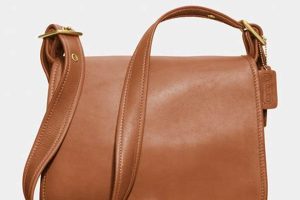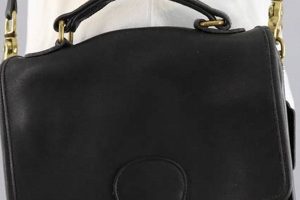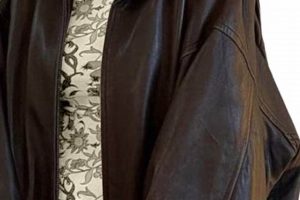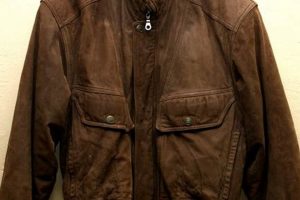These accessories, crafted from tanned animal hide and predating contemporary mass production, represent a tangible link to bygone eras. They are often characterized by distinctive designs, construction techniques, and hardware, reflecting the fashion sensibilities and manufacturing capabilities of their respective periods. Examples include structured doctor’s bags from the early 20th century and intricately tooled saddlebags from the mid-century.
Possessing one of these items offers several advantages. Beyond their aesthetic appeal and potential as collector’s items, they often embody superior craftsmanship compared to modern alternatives. Their durability, achieved through time-tested methods and high-quality materials, ensures longevity. Examining such an item provides insights into historical trends, social values, and the evolution of personal adornment.
The following sections will delve into aspects such as identification techniques, conservation strategies, authentication processes, and prominent styles throughout history. Understanding these facets is essential for appreciating the value and preserving the integrity of these unique artifacts.
Tips on Acquiring and Maintaining Vintage Leather Purses
This section provides essential guidance for individuals interested in acquiring, preserving, and appreciating these historical accessories. Careful consideration of these factors ensures both the authenticity and longevity of such an acquisition.
Tip 1: Examine Stitching and Hardware: Authentic pieces typically exhibit robust stitching and quality hardware commensurate with their era. Machine stitching became prevalent later, so hand-stitching might indicate an older piece. Evaluate buckles, clasps, and zippers for period-correct markings or materials.
Tip 2: Assess Leather Quality and Patina: High-quality leather, properly aged, develops a rich patina. Inspect for suppleness, even coloration, and subtle signs of wear that are consistent with the item’s age. Avoid items with excessive dryness, cracking, or flaking, as these may indicate irreversible damage.
Tip 3: Investigate the Lining and Interior: The lining material often reveals clues about the purse’s age and origin. Look for fabrics like silk, linen, or patterned cotton twill in older examples. Note the condition of the lining, as deterioration can affect the structural integrity of the item.
Tip 4: Research the Maker’s Mark: Identifying the manufacturer can significantly enhance value and aid in authentication. Examine the interior for stamped logos, embossed marks, or sewn-in labels. Research these markings to verify their validity and determine the purse’s provenance.
Tip 5: Consider the Style and Era: Familiarize yourself with prominent styles from different periods. Art Deco clutches, 1950s box bags, and 1970s hobo bags each possess distinct characteristics. Understanding these features helps to avoid misidentifying a reproduction or a later-style piece.
Tip 6: Obtain Professional Appraisal: For high-value or rare acquisitions, seeking an expert appraisal is advisable. A qualified appraiser can assess authenticity, condition, and market value, providing valuable information for informed decision-making.
Tip 7: Implement Proper Storage Techniques: To maintain its condition, store in a cool, dry environment away from direct sunlight. Stuffing it with acid-free paper when not in use will help retain its shape. Use a dust bag to protect from scratches and dust accumulation.
Adherence to these guidelines will facilitate the acquisition of genuine articles and promote their long-term preservation, thereby ensuring the continued appreciation of these valuable historical items.
The following section will discuss care and restoration to maintain these items’ value.
1. Material Integrity
Material integrity is paramount when evaluating the quality and longevity of accessories from earlier eras. The condition of the tanned hide directly impacts an item’s aesthetic appeal, structural stability, and overall value. Consequently, a thorough assessment of the leather is crucial for informed acquisition and preservation.
- Leather Type Identification
Different animal hides and tanning processes yield varying characteristics. Cowhide, goatskin, and exotic leathers like alligator or ostrich were commonly employed. Vegetable tanning, chrome tanning, and other methods each produce distinctive textures, durability, and aging properties. Identifying the specific leather type informs appropriate care strategies and assists in authentication.
- Patina and Aging Characteristics
Genuine items develop a unique patina over time, resulting from exposure to light, oils, and environmental factors. This natural aging process creates subtle variations in color and texture, enhancing aesthetic appeal. Conversely, artificial distressing techniques attempt to mimic this effect, but often lack the nuanced complexity of authentic patina.
- Signs of Degradation
Inspect closely for signs of deterioration, including cracking, dryness, stiffness, and mildew. These issues can compromise structural integrity and require specialized restoration techniques. Significant damage may diminish value and render the item unsuitable for practical use.
- Repair and Restoration History
Previous repairs and restoration efforts should be carefully assessed. While professional repairs can extend lifespan, poorly executed work can detract from value and potentially damage the leather. Identifying the nature and quality of past interventions is essential for determining long-term maintenance strategies.
By meticulously evaluating these facets of material integrity, collectors and enthusiasts can make informed decisions about acquiring, preserving, and appreciating these valuable historical artifacts. Proper assessment and care ensures these items retain their aesthetic appeal and historical significance for future generations.
2. Hardware Authenticity
The presence of original, period-correct hardware significantly impacts the value and historical accuracy of vintage leather accessories. Authenticity in this regard not only enhances the aesthetic appeal, but also provides crucial insights into the manufacturing techniques and design trends prevalent during the item’s creation.
- Material Composition and Manufacturing Techniques
Original hardware, such as clasps, buckles, zippers, and decorative elements, often reflects the materials and manufacturing technologies available at the time of production. Examples include the use of brass, nickel, or early forms of plastic. Manufacturing techniques might involve hand-tooling, casting, or early machining processes. The presence of these period-specific details serves as a marker of originality.
- Design and Style Consistency
Hardware designs were often integral to the overall aesthetic of the purse. Styles such as Art Deco geometric patterns or mid-century modern minimalist forms can be indicative of a specific era. Inconsistencies between the hardware style and the purported age of the item can raise questions about authenticity. Comparing hardware designs with documented examples from the period is crucial.
- Maker’s Marks and Patents
Many manufacturers imprinted their hardware with identifying marks or patent numbers. These markings provide valuable information for verifying authenticity and tracing the item’s origin. Researching these marks can lead to the discovery of historical records and advertisements that further validate the piece. The absence of expected marks, or the presence of incorrect marks, suggests potential issues.
- Wear Patterns and Patina
Genuine hardware will exhibit wear patterns consistent with the age and use of the item. A natural patina, resulting from oxidation and handling, is often present. Artificial distressing or inconsistent wear patterns can indicate that the hardware has been replaced or tampered with. Examination under magnification can reveal subtle differences between authentic patina and artificial aging.
The careful evaluation of hardware authenticity is essential for assessing the true value and historical significance of accessories. By considering the material composition, design consistency, maker’s marks, and wear patterns, collectors and enthusiasts can better appreciate the craftsmanship and history embodied in these unique artifacts.
3. Construction Quality
The correlation between construction quality and the value of vintage leather accessories is direct and profound. Superior construction not only ensures durability and longevity, but also serves as a hallmark of authenticity and craftsmanship, thereby increasing an item’s desirability among collectors. Careful attention to detail, the selection of appropriate materials, and the execution of precise stitching techniques contribute significantly to the overall quality and resilience of these items. For instance, a well-constructed doctor’s bag from the early 20th century, exhibiting tight, even stitching and reinforced stress points, is more likely to withstand the passage of time and retain its structural integrity compared to a mass-produced contemporary counterpart. The tangible result is a lasting artifact representing a bygone era’s commitment to enduring quality.
The assessment of construction quality extends beyond merely observing the external appearance of the accessory. Examining the internal structure, the lining material, and the method of attaching hardware reveals further insights into the artisan’s skill and the manufacturer’s standards. A handbag featuring hand-stitched seams, a robust frame, and a meticulously applied lining indicates a higher level of craftsmanship than one with machine-sewn seams, a flimsy frame, and a poorly attached lining. Similarly, the type of thread employed, whether it is linen or synthetic, impacts the item’s resistance to wear and tear. Understanding these subtle nuances allows collectors to differentiate between high-quality pieces and those that may be of lesser value or authenticity.
In summation, construction quality is an essential determinant of value and authenticity in vintage leather accessories. Careful examination of stitching, materials, and internal structure provides valuable clues about the item’s origin, craftsmanship, and potential longevity. Recognizing these key aspects empowers collectors to make informed decisions, ensuring that their acquisitions represent genuine examples of enduring artistry and historical significance. The enduring challenge lies in educating buyers to discern subtle signs of quality and thereby preserve the legacy of superior craftsmanship for future generations.
4. Historical Provenance
The historical provenance of these accessories significantly influences their value, collectibility, and overall significance. Provenance establishes a verifiable chain of ownership and contextualizes the item within specific historical events, social trends, or individual narratives. A handbag once owned by a notable figure, featured in a significant exhibition, or documented in period photographs possesses a value beyond its material composition. This documented history transforms it from a mere object into a tangible artifact of a bygone era. A lack of documented history reduces an item to its aesthetic qualities alone. This emphasizes that the knowledge of its journey throughout history adds layers of interest and legitimacy.
Establishing provenance often requires meticulous research, involving examination of purchase receipts, letters, photographs, and auction records. Conclusive evidence linking the accessory to a specific individual, event, or period enhances its market appeal and historical relevance. For instance, a leather purse attributed to a specific design house or a particular decade, supported by verifiable documentation, commands a higher premium due to its confirmed authenticity and place within the broader narrative of fashion history. The presence of unique characteristics attributable to a specific era or event provides invaluable insight.
Challenges in establishing historical provenance arise from the scarcity of documentation and the potential for fraudulent claims. Rigorous authentication processes, involving expert appraisers and historians, are essential to validate the alleged history of the item. Despite these challenges, understanding and verifying historical provenance remains a crucial aspect of collecting and appreciating these artifacts, ensuring that their stories are accurately preserved and transmitted to future generations. Knowing that a purse supported women as they ventured out into the work force, makes that specific historical purse even more meaningful to its collector.
5. Style Evolution
The evolving silhouettes, materials, and embellishments of vintage leather purses provide a tangible record of changing societal norms and aesthetic preferences. A direct correlation exists between socio-economic factors and the design of these accessories. For example, the austerity measures during wartime periods often resulted in simpler, more functional designs, utilizing less material and omitting elaborate ornamentation. Conversely, periods of economic prosperity typically saw the emergence of more extravagant styles, incorporating luxurious leathers, intricate detailing, and bold colors. Understanding this cause-and-effect relationship is crucial for accurately dating and appraising items. Therefore, recognizing style evolution as a component of vintage leather purses provides insight into culture.
Further illustrating this concept, the shift from structured, top-handle bags of the mid-20th century to the more relaxed, shoulder-slung styles of the 1970s reflects the changing roles of women in society. As women entered the workforce in greater numbers, they required more practical and functional designs that allowed for greater freedom of movement. Similarly, the emergence of minimalist, logo-centric designs in the 1990s mirrored the rise of consumerism and brand consciousness. Therefore, an understanding of these factors allows collectors to contextualize their items within a broader historical framework and appreciate their cultural significance.
In conclusion, the style evolution of vintage leather purses is inextricably linked to broader societal trends and economic conditions. By analyzing the design elements, materials, and construction techniques of these accessories, collectors and enthusiasts can gain valuable insights into the past and develop a deeper appreciation for their historical and cultural significance. Recognizing these interconnections presents a challenge of continually expanding knowledge, yet it remains essential for informed collecting, authentication, and preservation efforts, while it highlights their cultural and historical value.
Frequently Asked Questions
The following addresses prevalent inquiries and dispels misconceptions surrounding the acquisition, authentication, and preservation of vintage leather purses.
Question 1: How does one differentiate between genuine patina and artificial distressing?
Genuine patina develops gradually over time due to exposure to light, oils, and handling, resulting in subtle variations in color and texture. Artificial distressing often appears uniform, lacks depth, and may involve harsh chemicals or abrasive techniques that damage the leather.
Question 2: What constitutes appropriate storage for vintage leather purses?
Suitable storage involves a cool, dry environment away from direct sunlight and humidity. Purses should be stuffed with acid-free paper to maintain their shape and stored in dust bags to protect against scratches and dust accumulation.
Question 3: How can the authenticity of hardware be verified?
Authentication of hardware involves examining the material composition, design consistency, and presence of maker’s marks or patent numbers. Researching these marks and comparing the hardware to documented examples from the period is crucial.
Question 4: What are the primary indicators of quality construction in vintage leather purses?
Indicators of quality construction include tight, even stitching, the use of high-quality materials, reinforced stress points, and a well-executed lining. Hand-stitched seams and robust frames are also indicative of superior craftsmanship.
Question 5: How does historical provenance impact the value of a vintage leather purse?
Verifiable historical provenance, such as documented ownership by a notable figure or inclusion in a significant exhibition, significantly enhances an item’s value and collectibility by contextualizing it within specific historical events or narratives.
Question 6: What are the implications of restoration on the value of a vintage leather purse?
Professional and sympathetic restoration can enhance the aesthetic appeal and longevity of the item, but poorly executed or overly aggressive restoration can detract from its value. Disclosure of all restoration work is essential.
Careful consideration of these factors is essential for informed collecting and preservation, ensuring these artifacts retain their historical and aesthetic value.
The following section will discuss case studies and examples to further illustrate important points.
Conclusion
The preceding exploration has elucidated the multi-faceted nature of accessories from prior eras. Key aspects such as material integrity, hardware authenticity, construction quality, historical provenance, and style evolution collectively contribute to an item’s value and historical significance. Thorough evaluation of these factors is essential for informed acquisition and preservation.
Continued research and diligent preservation efforts are critical to ensuring that “vintage leather purses” remain accessible for future study and appreciation. Understanding their construction, historical context, and cultural value preserves tangible links to past generations, safeguarding these artifacts for posterity. Let those interested make strides to keep those treasures for a long time.







